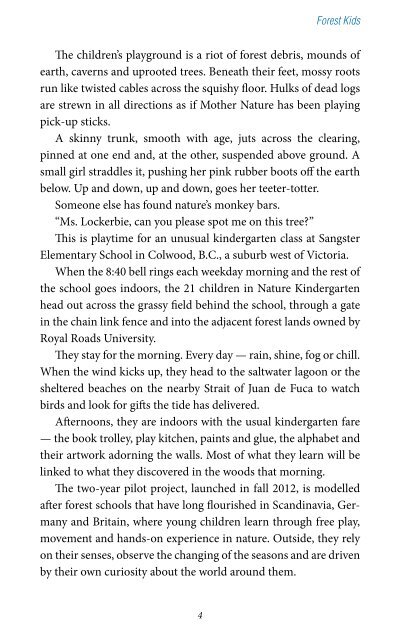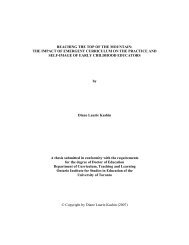Forest Kids
You also want an ePaper? Increase the reach of your titles
YUMPU automatically turns print PDFs into web optimized ePapers that Google loves.
<strong>Forest</strong> <strong>Kids</strong><br />
The children’s playground is a riot of forest debris, mounds of<br />
earth, caverns and uprooted trees. Beneath their feet, mossy roots<br />
run like twisted cables across the squishy floor. Hulks of dead logs<br />
are strewn in all directions as if Mother Nature has been playing<br />
pick-up sticks.<br />
A skinny trunk, smooth with age, juts across the clearing,<br />
pinned at one end and, at the other, suspended above ground. A<br />
small girl straddles it, pushing her pink rubber boots off the earth<br />
below. Up and down, up and down, goes her teeter-totter.<br />
Someone else has found nature’s monkey bars.<br />
“Ms. Lockerbie, can you please spot me on this tree?”<br />
This is playtime for an unusual kindergarten class at Sangster<br />
Elementary School in Colwood, B.C., a suburb west of Victoria.<br />
When the 8:40 bell rings each weekday morning and the rest of<br />
the school goes indoors, the 21 children in Nature Kindergarten<br />
head out across the grassy field behind the school, through a gate<br />
in the chain link fence and into the adjacent forest lands owned by<br />
Royal Roads University.<br />
They stay for the morning. Every day — rain, shine, fog or chill.<br />
When the wind kicks up, they head to the saltwater lagoon or the<br />
sheltered beaches on the nearby Strait of Juan de Fuca to watch<br />
birds and look for gifts the tide has delivered.<br />
Afternoons, they are indoors with the usual kindergarten fare<br />
— the book trolley, play kitchen, paints and glue, the alphabet and<br />
their artwork adorning the walls. Most of what they learn will be<br />
linked to what they discovered in the woods that morning.<br />
The two-year pilot project, launched in fall 2012, is modelled<br />
after forest schools that have long flourished in Scandinavia, Germany<br />
and Britain, where young children learn through free play,<br />
movement and hands-on experience in nature. Outside, they rely<br />
on their senses, observe the changing of the seasons and are driven<br />
by their own curiosity about the world around them.<br />
4


















